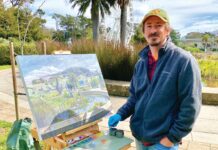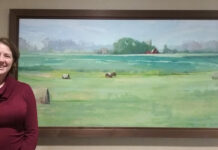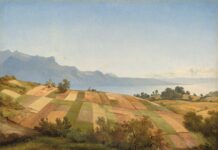
Michael Reardon, a watercolorist and featured instructor at the Plein Air Convention & Expo (PACE) was actually surprised to find out there were oil painters who painted outside. He has history on his side.

“Chaise Blanche,” by Michael Reardon, 2005, watercolor, 9 x 5 in.
“Watercolor is very old; it’s a traditional medium for plein air painting,” says Reardon. “And coming from an architectural background, I just assumed that watercolor was what you used outdoors. A Sargent exhibition in San Francisco showcasing his watercolor paintings from Venice reinforced my notion.”

“Hammock,” by Michael Reardon, 2007, watercolor, 9 x 6 in.
The Bay Area artist is not alone in pointing out that watercolor has significant logistical advantages in the field. There are no solvents, and the necessary water is usually available either from a natural or man-made source. Watercolor paintings dry quickly, stack easily, and pack lightly. The medium of watercolor demands freshness and spontaneity, as does plein air painting. Reardon says he generally spends 30 minutes to an hour on a plein air watercolor. The variance is partly explained by the fact that it will take Reardon longer if a more extensive line drawing is necessary — for instance, if the scene has complicated perspective lines or buildings. “If I spend much more time than that on a painting, it usually means that I’ve ruined it,” he says.

“Calle del Convento,” by Michael Reardon, 2014, watercolor, 14 x 6 in.
Whether in the studio or outdoors, Reardon’s approach is the same. He executes a 3″-x-5″ study sketch, then puts down a line drawing using a 2B graphite mechanical pencil. (In the field, the paper is generally a quarter-sheet, or about 9″ x 14″.) In the studio, and when convenient in the field, he will use an easel, but Reardon is content to tape his paper to some heavy cardboard and hold it in his hand. A pad of watercolor paper works well, too, although this is a less economical option. Either way, Reardon can turn and tilt the surface at will to urge the watercolor paint to flow in the direction he prefers. Reardon puts down a light wash with blue and orange, preserving his whites, and lets that dry. Then he works from top to bottom. “I let it run where it wants and try not to go back and paint on top,” Reardon says. “I’m just trying to create an impression rather than an accurate description of something. You have to let watercolor be watercolor. You have to let things happen. It’s a hard thing for people to learn, to let it go. But then when you come back to it a few days later, you say, ‘How did I do that?’ And it looks great.”

“Lago Atitlan,” by Michael Reardon, 2014, watercolor, 10 x 5 in.
At PACE, Reardon will be demonstrating how his approach to watercolor blends the precise with the unpredictable. Watercolor is a mercurial partner for a painter, and this means that the painter must both be very prepared and quite open to unexpected developments. “With watercolor, if you want to paint quickly, you really have to know where you are going and have a lot of it figured out in your head,” says Reardon. “I work quickly and paint direct and wet-in-wet.” This does not preclude loose washes of color. “Doing architectural illustration required me to be very, very precise,” he recalls. “When I first started going outdoors I rejected all of that and completely loosened up. I didn’t worry about telling someone a story. In the studio, it was easier to control the situation, which made me tighter. It can lead to tighter and less expressive paintings. Since that’s something I generally don’t want, I strive to maintain the plein air effect in my studio work.”

“Borgo Corsignano,” by Michael Reardon, 2013, watercolor, 14 x 7 in.
Reardon will be teaching at the Plein Air Convention & Expo, which will be held April 13-17 in Monterey, California. Last year, more than 700 artists basked in the perfect weather and learned from 70 instructors. This year, organizers expect even more participants. Learn more here.




